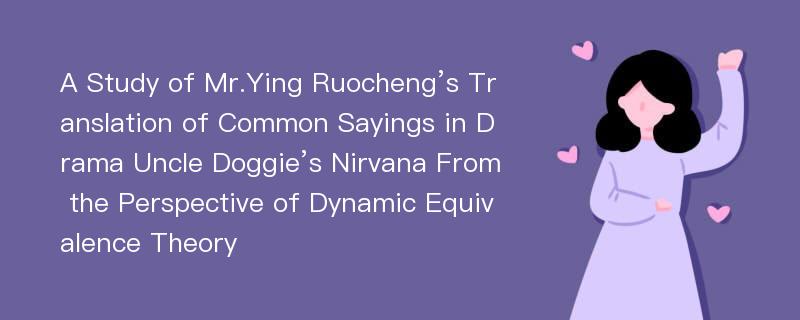
论文摘要
本论文主要运用动态对等理论来分析英若诚先生所译《狗儿爷涅槃》中俗语的翻译。话剧翻译在一定程度上不同于其他文体的翻译。话剧的主要目的是在观众面前表演,它的语言一方面必须易于为观众理解,另一方面又要口语化,易于演员表演。因此,具有一定文化特殊性的俗语就为话剧的翻译带来了不小的困难。当然也就更值得我们对其进行研究。尤金·A·奈达提出了著名的动态对等理论。动态对等理论强调观众的反应,因此在翻译中追求表达上的自然,效果上的对等,这与话剧翻译在根本上是一致的,因为如果话剧译本表达上不自然,则演员无法上口,观众也很难立即体会和欣赏其中的妙处。牵涉文化层面的翻译往往比较棘手,尤其是在话剧翻译中。忽视表达的自然和意义的传达而过于保留原文的形式是不可取的,因为这很难给观众留下深刻的印象,因而动态对等理论为话剧中具有文化特殊性的俗语的翻译提供了一条很好的出路。本论文由五部分组成。第一部分为简要介绍;第二部分陈述了话剧的特点及国内外的话剧翻译理论;第三部分论述了奈达的动态对等理论;第四部分详细分析了《狗儿爷涅槃》中俗语的翻译:第五部分为结论部分。
论文目录
AcknowledgementsAbstract in EnglishAbstract in ChineseContentsI. IntroductionII. Characteristics of Drama and Theories of Drama Translation2.1 Play, Drama, Theatre and Spoken Drama2.2 The Dual Nature of Drama2.3 Theories of Drama Translation2.3.1 Theories of Drama Translation in China2.3.1.1 Zhu Shenghao and Yu Guangzhong2.3.1.2 Ying Ruocheng2.3.1.3 Features Shared by The Three Figures2.3.2 Theories of Drama Translation in Western Countries2.3.2.1 George E. Wellwarth2.3.2.2 Clifford E. Landers2.3.2.3 Sirkku Aaltonen2.3.2.4 Susan Bassnett2.3.3 Similarities between Chinese and Western Theories of Drama TranslationIII. Nida and His Dynamic Equivalence3.1 Nida3.2 Nida's Definition of "Translation" and The Word "Message"3.3 Formal Equivalence and Dynamic Equivalence3.3.1 Formal Equivalence3.3.2 Dynamic Equivalence3.3.2.1 Definition of Dynamic Equivalence3.3.2.2 The Word "Natural"3.3.2.3 Formal Adjustments in D-E Translation3.3.2.4 Tendency to Dynamic Equivalence3.3.3 Functional Equivalence3.3.3.1 Functional Equivalence and Readers' Response3.3.3.2 Functional Equivalence and Isomorphs3.3.3.3 Formal and Functional Equivalents3.3.3.4 Drama Translation3.4 Characteristics of Nida's Dynamic Equivalence3.5 D E Translation and Its Classifications3.5.1 Closest D-E Translation3.5.2 Literal Translation3.5.3 Free translation3.6 Links between D-E Translation and Drama TranslationIV. An Analysis of Mr. Ying Ruocheng's Translation of The Common Sayings (俗语) in Uncle Doggie's Nirvana4.1 Uncle Doggie's Nirvana4.2 Common Sayings and Their Classifications4.3 The Analysis of Mr. Ying Ruocheng's Translation of The Common Sayings4.3.1 Proverbs (谚语)4.3.1.1 Closest D-E Translation4.3.1.2 Literal Translation4.3.1.3 Free translation4.3.2 Locutions (惯用语)4.3.2.1Closest D-E Translation4.3.2.2 Literal Translation4.3.2.3 Free translation4.3.3 Two-Part Allegorical Sayings (歇后语)4.3.3.1 Closest D-E Translation4.3.3.2 Literal Translation4.3.3.3 Free translation4.3.4 Popular Idioms (俗成语)4.3.4.1 Closest D-E Translation4.3.4.2 Literal Translation4.3.4.3 Free translationV. ConclusionBibliography
相关论文文献
- [1].秦腔《狗儿爷涅槃》:文本与舞台的再创造[J]. 当代戏剧 2017(01)
- [2].有“魔力”的《狗儿爷涅槃》[J]. 东方艺术 2017(05)
- [3].话剧《狗儿爷涅槃》《桑树坪纪事》在演剧上对戏曲的借鉴[J]. 四川戏剧 2017(06)
- [4].话剧《狗儿爷涅槃》的叙事空间建构[J]. 四川戏剧 2017(10)
- [5].反讽的力量:锦云《狗儿爷涅槃》新解[J]. 中国戏剧 2014(03)
- [6].狗儿爷涅槃[J]. 中国戏剧 2014(09)
- [7].《狗儿爷涅槃》[J]. 新剧本 2020(02)
- [8].《狗儿爷涅槃》之后——锦云剧作道路转型得失探因[J]. 文教资料 2008(30)
- [9].别样的狗儿爷:秦腔《狗儿爷涅槃》文本与舞台的再创造[J]. 剧作家 2017(01)
- [10].感言[J]. 剧本 2017(06)
- [11].浅谈戏剧《狗儿爷涅槃》的悲剧性[J]. 丝绸之路 2013(06)
- [12].《狗儿爷涅槃》的悲剧性——基于亚里士多德《诗学》的悲剧理论[J]. 美与时代(下) 2020(09)
- [13].秦腔现代戏《狗儿爷涅槃》观后记[J]. 戏剧之家 2018(16)
- [14].“反思”中的自由践行——我排秦腔《狗儿爷涅槃》[J]. 戏曲研究 2020(02)
- [15].当代戏剧《狗儿爷涅槃》的作品内涵[J]. 大舞台 2012(08)
- [16].典型的重量——重温锦云的话剧《狗儿爷涅槃》[J]. 戏剧文学 2008(12)
- [17].我演《狗儿爷涅槃》中的李万江[J]. 中国戏剧 2016(10)
- [18].看秦腔《狗儿爷涅槃》[J]. 中国戏剧 2016(02)
- [19].一个人,一段历史——评刘锦云剧作《狗儿爷涅槃》[J]. 绥化学院学报 2011(02)
- [20].《狗儿爷涅槃》:农民与土地及命运的纠缠[J]. 名作欣赏 2011(24)
- [21].穿越时代的梦想 秦腔《狗儿爷涅槃》惊艳西安[J]. 中国戏剧 2016(11)
- [22].两种诗意的“写实”——以《安娜在热带》《狗儿爷涅槃》为例[J]. 艺术品鉴 2019(32)
- [23].知民情 纾民怨的慷慨悲歌 秦腔《狗儿爷涅槃》观后[J]. 中国戏剧 2017(01)
- [24].浅谈秦腔《狗儿爷涅槃》的剧作结构与表演[J]. 戏剧之家 2018(27)
- [25].经典的魅力——浅议《狗儿爷涅槃》[J]. 当代戏剧 2017(05)
- [26].林连昆与《狗儿爷涅槃》[J]. 中国戏剧 2010(01)
- [27].新皮袋里装新酒[J]. 中国戏剧 2016(02)
- [28].一部现实主义的探索剧——《狗儿爷涅槃》赏析[J]. 电影文学 2008(06)
- [29].中国农民的代言人——浅析话剧《狗儿爷涅槃》中的狗儿爷形象[J]. 戏剧之家(上半月) 2014(03)
- [30].每个人都是自己人生的编剧[J]. 中华儿女 2015(20)
标签:话剧翻译论文; 动态对等论文; 英若诚论文; 狗儿爷涅槃论文; 俗语论文;
A Study of Mr.Ying Ruocheng’s Translation of Common Sayings in Drama Uncle Doggie’s Nirvana From the Perspective of Dynamic Equivalence Theory
下载Doc文档
